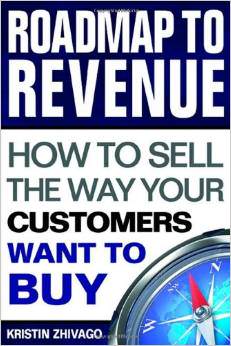5 Steps to Customer-Centric Sales
Entrepreneurs always work hard to create an innovative product or service, but often count on standard seller marketing for sales. But the reality is that sellers are no longer in charge of the customer buying process. Recent reports [Edit: the report no longer appears on the chiefmarketer.com website] suggest that 90% of today’s shoppers skip marketing pitches, to research online before they buy, and over 50% check user reviews before making a decision.
The Internet and smartphones have changed everything. Kristin Zhivago, in her new book “Roadmap to Revenue,” makes the point that the selling system is broken, since sellers no longer sell the way customers are buying. Here is my summary of her detailed roadmap to get you back on the right track with a “customer-centric” approach rather than a “company-centric” approach:
- Find out what customers want and how they want to buy it. The best way to do this is with real customer interviews. Customers will tell you things when being interviewed that they will never tell you while you are selling to them. She recommends phone interviews by you, by appointment, with structured questions, and you document results.
- Debate and adjust your offering to better match what customers want. Distribute an Executive Summary and Recommendations report, as well as transcripts of your interviews, to all the key players in your company. Schedule and run the necessary sessions to update strategic product offerings, processes, and marketing programs.
- Align your business model to how your customers want to buy. Don’t start with how you want to sell. Start with a new understanding of the real customer need, their search process in finding you (referral, website, social media), and most desired payment model, like one-time payment versus subscription, or lease versus purchase.
- Integrate the customer buying process into your support operation. Decide which parts can be automated, people resources required, and customer service points of contact. All of these processes should be documented, and should explicitly include the customer buying process and perceptions as the base. Their perception is your reality.
- Build and deploy a revenue growth action plan. This is your rollout of the new product offerings, business model updates, and process changes to map to the new understanding of the customer buying process. Include planned measurements and metrics. Start where the customer wants you to be and work backward.
As you start making the shift to customer-centric, if your team doesn’t “get it,” then you haven’t communicated effectively. Communicating change is always hard, so pay careful attention to the central message, repetition opportunities, and “walking the talk.” People are quick to make things up to fill a vacuum, and rumors or myths die hard.
Make sure your own motivation is strong, and don’t let anyone view these efforts as a one-time push. It has to be managed and sold internally as a culture change, requiring everyone’s help. Experience has shown that the best way to change a process is to set up the new way of doing things, then flip the switch (flip method), rather than making incremental changes (drip method).
Every business needs to take advantage of the new tools and technologies which can assist you in making this shift in strategy and measuring effectiveness. These range from basic search engine optimization (SEO) tracking, like Google Analytics, to a new generation of marketing platforms, like HubSpot.
There are multiple benefits to both you and your customer. The customers will get what they want when they want it, and you will see more revenue, greater brand loyalty, real relationships, and a competitive edge. That sounds to me like the recipe for business success that every investor is looking for.

